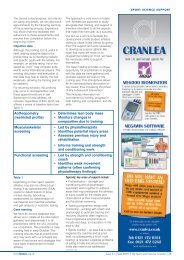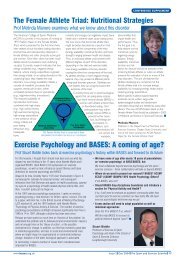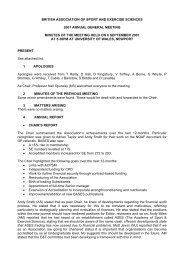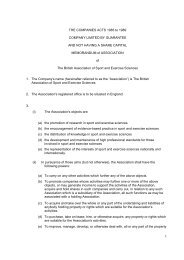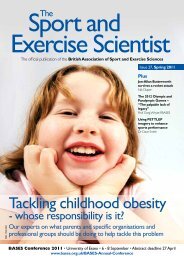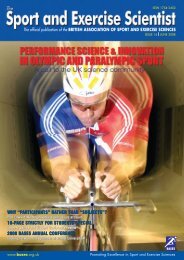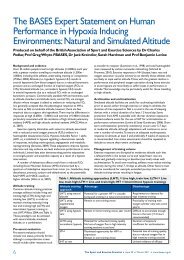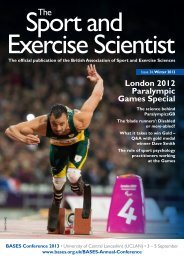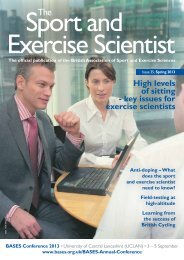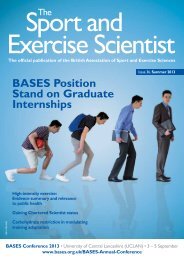Issue 31 Spring 2012 - Bases
Issue 31 Spring 2012 - Bases
Issue 31 Spring 2012 - Bases
Create successful ePaper yourself
Turn your PDF publications into a flip-book with our unique Google optimized e-Paper software.
The dynamometer moment can also be affected by several other<br />
factors such as gravitational forces, the effect of biarticular muscles<br />
and the angle of the adjacent joint they span, antagonistic activity and<br />
the familiarisation and motivation of the participant, so it is important<br />
to include appropriate correction and standardisation procedures<br />
and to report relevant techniques or settings (e.g., control and<br />
report ankle joint angle during knee flexion tests to standardise<br />
the contribution of gastrocnemius to knee flexion moment). Verbal<br />
motivation and/or visual feedback can be provided to maximise<br />
activation but they must be consistent and standardised for all<br />
participants with clear instructions on how to use visual feedback.<br />
There are also mechanical issues related to the acceleration of the<br />
segments and since the dynamometer moment is equal to the joint<br />
moment only during the isovelocity period, the angular velocity must<br />
be monitored throughout the joint motion and any acceleration<br />
phases should be discarded, so that moment data are measured only<br />
from the isokinetic phase of the movement (see Baltzopoulos, 2008).<br />
Isokinetic dynamometers should be serviced and calibrated<br />
regularly. Independent criterion-based measurements of moment,<br />
angle and angular velocity should be compared with dynamometer<br />
readings so that data accuracy after calibration can be quantified (see<br />
Baltzopoulos, 2008).Raw moment and angle data should be smoothed<br />
with appropriate filters to remove high frequency noise. If a model<br />
of joint moment output is required (e.g., for simulation purposes),<br />
then each isovelocity moment-angle region should be identified and<br />
interpolated to provide moment as a function of angle at intervals of<br />
1º. A nine-parameter moment-angle-angular velocity function fitted<br />
to isovelocity moment-angle-angular velocity data is adequate for<br />
obtaining a participant-specific representation of maximal voluntary<br />
moment as a function of angle and angular velocity (King et al., 2006;<br />
Yeadon et al., 2006).<br />
Isokinetic assessment of children provides researchers with<br />
additional challenges relating to changing and individual rates of<br />
growth and maturation. Modifications are necessary for isokinetic<br />
dynamometer seat and attachments and stabilisation and testing<br />
procedures (e.g. static or anthropometry-based procedures instead<br />
of dynamic gravity correction). Isokinetic testing of children,<br />
irrespective of muscle action or muscle joint assessed, has a testretest<br />
variation of around 5-10% similar to adult variation. Generally<br />
it is reproducible and reliable as long as equipment and protocols<br />
are properly adapted for their size and good habituation procedures<br />
are in place, especially during eccentric actions (De Ste Croix et al.,<br />
2003). Interpretation of isokinetic moment data during growth and<br />
maturation requires comparisons among individuals of different sizes.<br />
It is therefore important that a size-free moment variable is used<br />
for interpretive purposes. Current evidence suggests that allometric<br />
scaling factors should be derived from careful modelling of individual<br />
data sets, and therefore be sample specific rather than adopting<br />
conventional ratio-standard scaling indices.<br />
Isokinetic dynamometry has also been used in clinical<br />
applications to assess the effects of surgical and rehabilitative<br />
interventions on neuromuscular performance. It has been deployed<br />
most often as a secondary outcome (mainly peak moment)<br />
alongside primary outcomes of functionality and minimised pain.<br />
In experimental designs for clinical interventions and meaningful<br />
changes, effect sizes of indices of neuromuscular performance<br />
involving isokinetic dynamometry are approximately 0.3 to 2.5. Raw<br />
effects associated with monitoring clinical changes in performance<br />
might exceed those observed for asymptomatic populations because<br />
of potentially lower disease-, injury- or de-conditioning-related<br />
baselines. However, the greater heterogeneity of responses in<br />
clinical evaluations at given stages of treatment might work against<br />
favourable or robust relative effect sizes. Thus, considerations for<br />
establishing appropriate experimental design sensitivity and avoidance<br />
of inflated Type-II error rates for a given least significant difference or<br />
clinical responsiveness might be judged using established procedures<br />
(Mercer & Gleeson, 2002). This is notwithstanding the documented<br />
limits to measurement precision and reproducibility in asymptomatic<br />
and clinical populations associated with isokinetic dynamometry due<br />
to the factors explained above.<br />
Conclusions and recommendations<br />
To obtain accurate joint moment-angle-angular velocity data for<br />
the assessment of strength and safeguard validity and reliability of<br />
strength measurements it is important that:<br />
• dynamometers are serviced regularly and calibrated according<br />
to recommended techniques using a range of weights to confirm<br />
moment measurements and accurate goniometers are used to<br />
confirm angle measurements<br />
• the participant is positioned and stabilised appropriately on the<br />
dynamometer including adjacent joints of biarticular muscles<br />
• joint and dynamometer axes are aligned under active and not<br />
passive conditions, near the anticipated maximum moment<br />
position and separately for reciprocal actions (e.g., extension and<br />
flexion tests)<br />
• gravity and any other relevant correction techniques are applied<br />
• an appropriate testing protocol with standardised procedures<br />
for habituation, feedback and motivation is used<br />
• maximal range of motion is set, with preloading if necessary, to<br />
allow the participant to reach maximum voluntary activation and<br />
the preset joint velocity and to maximise the isokinetic phase<br />
• angular velocity is monitored and only isovelocity regions of<br />
each trial are used for subsequent analysis(velocity within 10% of<br />
the preset value)<br />
• acceleration period data and derived parameters (such as<br />
‘torque acceleration energy’) should not be used because they<br />
are affected by the different velocity control mechanisms of each<br />
dynamometer<br />
• stabilisation and joint axes alignment methods, correction<br />
techniques, test parameters, and isovelocity assessment method<br />
in high angular velocity tests must be reported explicitly.<br />
Bill Baltzopoulos is Professor<br />
of Biomechanics in the School<br />
of Sport and Education and the<br />
Centre for Sports Medicine and<br />
Human Performance<br />
at Brunel University<br />
in London and a<br />
BASES accredited<br />
sport and exercise<br />
scientist (Research).<br />
Nigel Gleeson is Professor<br />
of Exercise and Rehabilitation<br />
Sciences in the School of<br />
Health Sciences at Queen<br />
Margaret University<br />
in Edinburgh and a<br />
BASES accredited<br />
sport and exercise<br />
scientist (Research).<br />
References<br />
Arampatzis, A. et al. (2004). Clinical Biomechanics, 19, 3, 277-283.<br />
Baltzopoulos, V. (2008). Isokinetic dynamometry. In Biomechanical Evaluation of<br />
Movement in Sport and Exercise: BASES Guidelines (pp. 103-128), Routledge, London.<br />
De Ste Croix, M.B.A. et al. (2003). Sports Medicine, 33, 10, 727-743.<br />
Kaufman,K. et al. (1995). Journal of Biomechanics, 28, 10, 1243-1256.<br />
King, M. A. et al. (2006). Journal of Applied Biomechanics, 22, 264-274.<br />
Mercer, T.H. & Gleeson, N.P. (2002). Physical Therapy in Sport, 3, 1, 27-36.<br />
Tsaopoulos, D. et al. (2011). Journal of Applied Physiology, 111, 1, 68-74.<br />
Yeadon, M.R. et al. (2006). Journal of Biomechanics, 39, 476-482.<br />
PDF Download Download a PDF of this article<br />
www.bases.org.uk/BASES-Expert-Statements<br />
Dr Mark King is Senior<br />
Lecturer in Sports Biomechanics<br />
in the School of Sport, Exercise<br />
and Health Sciences<br />
at Loughborough<br />
University and a<br />
BASES accredited<br />
scientist sport<br />
and exercise<br />
scientist<br />
(Research).<br />
Dr Mark De Ste Croix is a<br />
Reader in Paediatric Sport and<br />
Exercise in the School of Sport<br />
and Exercise at<br />
the University of<br />
Gloucestershire.<br />
He is a BASES<br />
accredited<br />
sport and<br />
exercise scientist<br />
(Research).<br />
Copyright © BASES, <strong>2012</strong><br />
Permission is given for reproduction in substantial part. We ask that the following note<br />
be included: “First published in The Sport and Exercise Scientist, <strong>Issue</strong> <strong>31</strong>, <strong>Spring</strong> <strong>2012</strong>.<br />
Published by the British Association of Sport and Exercise Sciences – www.bases.org.uk”<br />
The Sport and Exercise Scientist n <strong>Issue</strong> <strong>31</strong> n <strong>Spring</strong> <strong>2012</strong> n www.bases.org.uk<br />
13



